Europa (Jupiter)
Contents
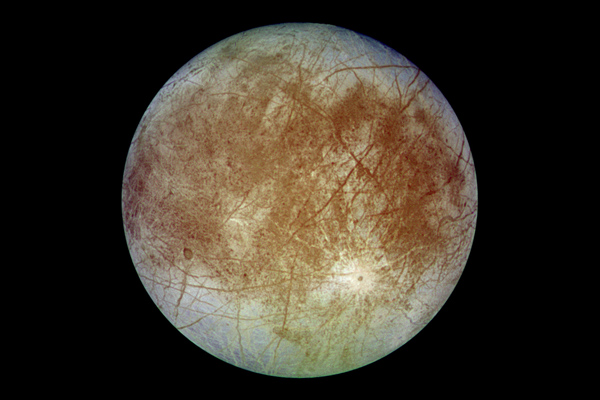 Europa trailing hemisphere in approximate natural color / nasa.gov
Europa trailing hemisphere in approximate natural color / nasa.govEuropa is the moon of astronomers dreams, a planetary object that may contain a basic form of life that exist hidden beneath its icy surface. Data collected on the behavior of the planet has given scientist the strong belief that contained within the ice of the planet lays a deep flowing ocean. If this ocean exist there is a high probability that Europa is habitable or may already sustaining some sort of life form. A future mission has been planed for a deep ocean type probe to drill into the ice of the moon and explore into this speculation to see if it is true or not. Until the mission comes into effect, however, there is very little definitive information on this mysterious moon.
Discovery
On January 7, 1610 Galileo Galilei was observing the, now known as the Galilean moons, Io, Ganymede, and Callisto. The next day, another observation showed that what Galileo thought was one moon Io, was in fact two moons, Io and Europa. At the same time, independently, Simon Marius also made this observation of Europa. As a result both Galileo and Simon were both named as its discoverers by the IAU (International Astronomical Union). Following the name of its parent planet Jupiter (aka Zeus), Europa was given the name of one of Zeus's lovers, the daughter of the king of Tyre.
Position to Jupiter
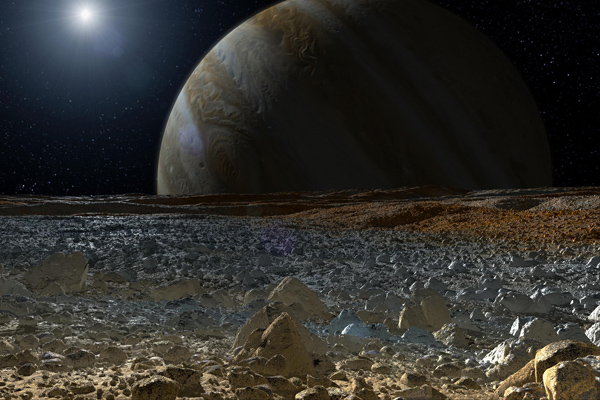 Simulated View from Europa's Surface (Artist's Concept) / nasa.gov
Simulated View from Europa's Surface (Artist's Concept) / nasa.govEuropa is approximately 670 thousand km (416 thousand miles) from Jupiter and orbits the planet at an eccentricity of .009 in a near circular orbit. It is tidal locked with Jupiter so only one side is seen from Jupiter at all times and it takes approximately 3 ½ days to orbit the planet. Because of its distance from the sun, Europa receives much of its heat either internally or from tidal forces from Jupiter.
The tidal forces create a tidal flexing effect on the moon, similar to breathing, which creates heat within the planet. The moons movement along with the tidal flex has led scientist to believe in the existence of a liquid ocean beneath its icy surface as a result. Its equator is typically around -160°C (-260°F) and its poles are averaging around -220°C (-370°F) in their temperatures, so its surface is solid ice.
Internal Structure
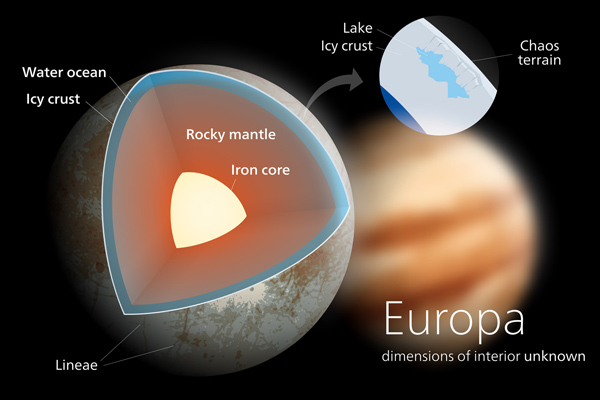 Internal Structure of Europa / wikimedia.org
Internal Structure of Europa / wikimedia.orgThere is very little that is known about the internal structure of Europa. It is strongly believed that it may contain a metallic core, such as iron, but it is unknown if it has a solid, molten, liquid core combination like Earth or not. It's mantle is believed to contain two layers. One layer consist of a silicate rock and the second layer is a salty ocean approximately 100 km (62 miles) deep. It is also believed that Europa contains tectonic plates just like Earth.
Surface/Geography
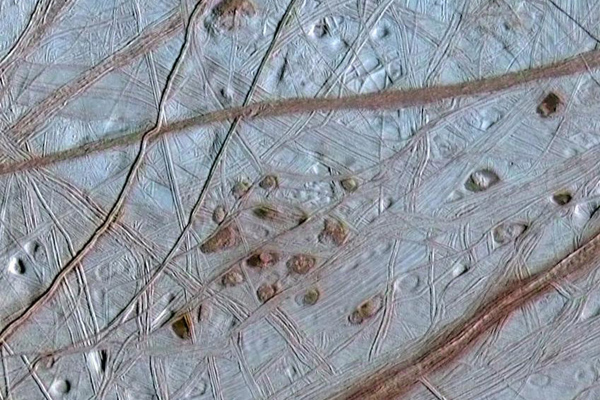 Ruddy "Freckles" on Europa / nasa.gov
Ruddy "Freckles" on Europa / nasa.govEuropa's surface is covered with ice and is the smoothest landscape in the solar system. All that is noticeable on the surface is long crisscrossing linear fractures. The most interesting aspect of Europa is the hypothesized subsurface ocean that may exist beneath the ice. It is strongly believed that if this ocean does exist, than there is a possibility that primitive forms of life such as bacteria may exist there as well.
The Galileo orbiter's instruments have also detected an induced magnetic field, this gives for even stronger evidence that a salt liquid water would need to exist under the surface. The gravity on Europa is extremely weak. For a 68 kg (150 lbs) person on Earth, on Europa they would only weigh 9 kg (20 lbs).
Atmosphere/Climate
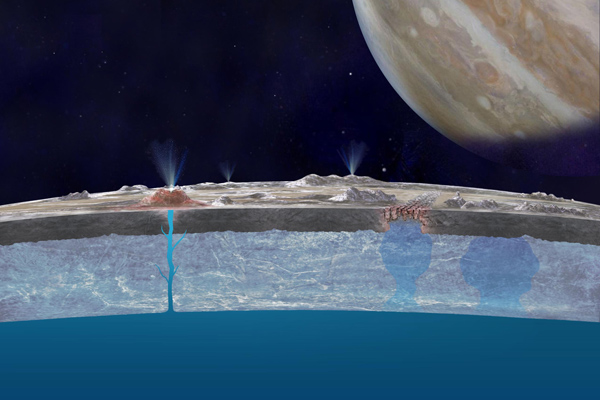 Taste of the Ocean on Europa's Surface / nasa.gov
Taste of the Ocean on Europa's Surface / nasa.govSpectrograph readings from the Hubble Space Telescope shows that Europa's atmosphere consist primarily of oxygen. This comes as a result of ultraviolet radiation interacting with the ice water on the surface splitting the water into oxygen and hydrogen and then pushing it into the air. This process is called radiolysis. This creates a form of atmosphere on the planet, though the atmosphere would be too thin to breath without a helmet not to mention that is created by non-biological means unlike Earth's oxygen which is 21% biologically created.
Exploration
There have been several flybys in the past of Europa by spacecrafts that were passing through and observing Jupiter. This included the Pioneer 10 and 11 in the 1970's and the Galileo Space Probe in the 1990's that has been orbiting Jupiter for 8 years. The most anticipated mission is the Europa Clipper and Europa Orbiter which is due to launch in by 2020. These missions are designed to gain a better understanding of Europa's surface, prove that there is an internal ocean, and to search for the possibility of life on another world.
See also: All satellites and moons, Jupiter's satellites and moons, Jupiter, Enceladus, Objects
Video Gallery

-
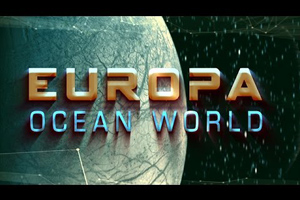 Europa: Ocean World
Europa: Ocean World
-
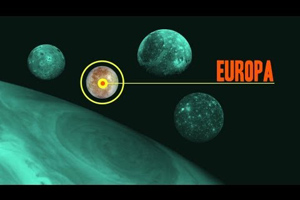 Four incredible things about Europa
Four incredible things about Europa
-
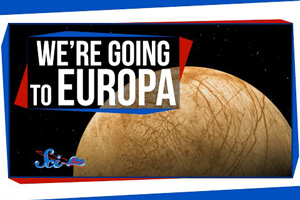 We're Going to Europa!
We're Going to Europa!
-
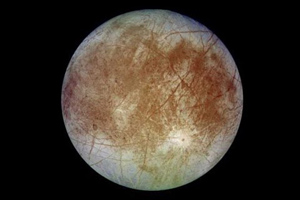 Sound of Europa NASA Voyager Space Sounds
Sound of Europa NASA Voyager Space Sounds